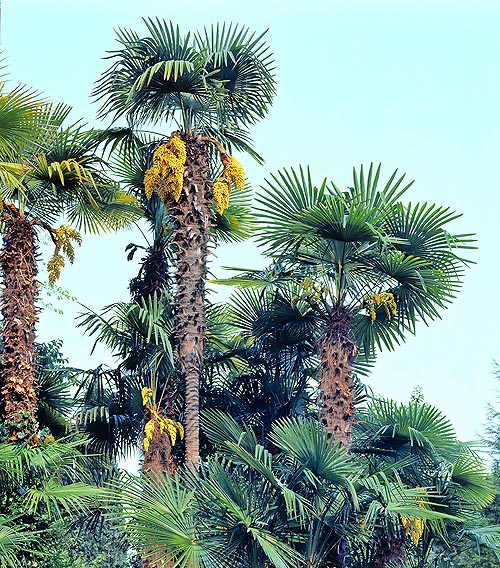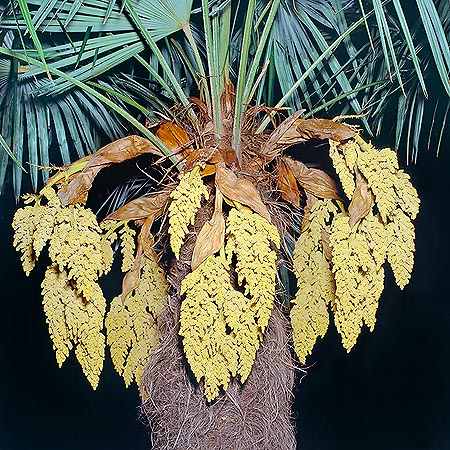Family : Arecaceae

Text © Pietro Puccio

English translation by Mario Beltramini

Trachycarpus fortunei © Giuseppe Mazza
The name of the species is honoured to the Scottish botanist Robert Fortune (1812-1880).
The Trachycarpus fortunei (Hook.) H. Wendl. (1861) is native to a vast area spreading from central China to northern Myanmar, where it grows in humid woody areas up to more than 2.200 metres of altitude.
The names commonly utilized are: “shan zong” , “zong lü”, “zong shu” (Chinese); chamaerops excelsa (Italian); “Chinese hemp palm”, “Chusan palm”, “hemp palm”, “windmill palm”, “Chinese windmill palm” (English); “chanvre de Chine”, “palmier chanvre”, “palmier de Chine”, “palmier Moulin”, “palmier de Chusan” (French); “Echte Hanfpalme”, “Hochstämmige Hanfpalme”, “Palmvezel” (German); “palma de fortune”, “palma de jardin”, “palmera china de abanico”, “palmera de molino de viento”, “palmito elevado”, “traquicarro” (Spanish); “cânhamo da China”, “palmera de canamo” (Portuguese).
This splendid palm has a characteristic solitary trunk, thin (about 20 cm of diameter) and tall up to about 10 m, covered by a thick coat of brown-grey hair and by the remains of the foliar petioles. The leaves of the Trachycarpus fortunei are palmate, of dark green colour on the upper page and slightly greyish in the lower one. Usually, they reach the 90 cm of length, and are cut for about one half of their length in thin segments, usually hanging. The petiole, long about 80-90 cm, is just indented on the margins.

Inflorescences of Trachycarpus fortunei © Giuseppe Mazza
The inflorescences are produced among the leaves (interfoliar). They are short and much ramified, of an intense yellow colour. The fruits are reniform, black and covered by a bluish waxy patina, and are about 12 mm long. The plant easily reproduces by seed, which germinates in about 3 months.
Due to its well known resistance to the low temperatures (around -15 °C) and its fast growth, it is the most diffused palm in the cold-temperate climate regions all over the world.
In certain areas, particularly suitable from the point of view of the humidity, the Trachycaspus fortunei has even become spontaneous.
In China, the fibres taken off from the trunk have several utilizations in the local handicraft.
Synonyms : Chamaerops fortunei Hook. (1860); Trachy- carpus caespitosus Becc. (1915); Trachycarpus wagnerianus Becc. (1921).
→ For general notions about ARECACEAE please click here.
